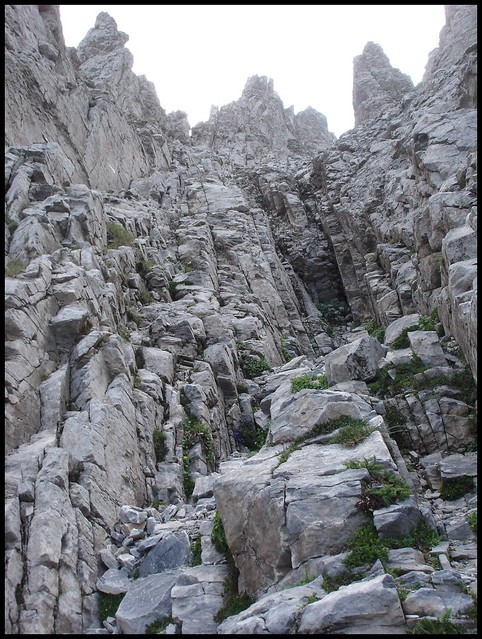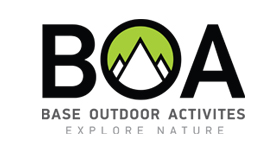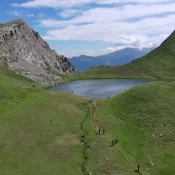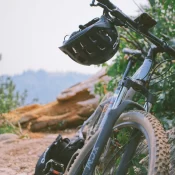
The Gully of Mytikas
The Gully of Mytikas
The first time I found myself in the Gully of Mytikas, at the age of 19, I felt a sense of awe that I had never experienced before. The steep path, sculpted by winds and centuries, stood before me like a divine test, inviting me to challenge my limits. The air was cold and sharp, filled with the scent of stone and the weight of history. Mount Olympus, the mountain of the gods, seemed alive. Each step brought me closer to the realization that I wasn’t just climbing a mountain but an invisible ladder toward the sky.
Looking up, I saw the Gully standing threateningly, like a crack in the rock leading to the highest peak of Greece, Mytikas. Its wild slopes and vertical ascent seemed insurmountable. My thoughts raced. Can I do it? Will I conquer this primeval passage? Or will I become just another one of those who turned back in the face of Olympus’ relentless power?
The Gully is not just a path; it’s a challenge. A meeting with the past, the present, and the unknown hidden in every peak. Every step required determination, every breath was careful, as if my very existence depended on it. The rocks, rough and sharp, forced me to recognize my smallness in the face of the mountain’s grandeur.
And yet, despite the fear and uncertainty, something inside me glowed. The Gully, with its wild beauty, was not just a route to the summit. It was a cleansing. A path that makes you leave behind what you think you know about yourself and emerge on the other side changed, stronger, and more real.
Starting the ascent, I knew this path was not for the weak. But for those who dare, for those who can look fear in the eye and move forward, the Gully of Mytikas offers something far more valuable than the view from the summit: a sense of absolute freedom and connection with the immortal.
I made my first ascent of the Gully of Mytikas alone. Call it foolishness, call it ignorance, but at that time, when I was 19, adrenaline and confidence overshadowed any thoughts of danger. The idea that I could face the mountain itself, without knowledge or experience, seemed like an exciting adventure. I didn’t realize then how close I was to the edge of the unpredictable.
Surviving that ascent was purely a matter of luck. As my feet struggled to hold on to the hard, steep slopes of Olympus, my mind could not fully grasp the danger. There were no ropes, no technical support—just me and the mountain. Each step was a confrontation with the unknown. The weather changed abruptly, the rocks were slippery, and I just kept going, unaware of how close I was to the limits of my strength.
Years later, when I had become a member of the EOS Thessaloniki and learned the basics of mountaineering, I realized how irresponsible and dangerous that first attempt had been. The techniques I learned for handling ropes, securing myself on steep slopes, preparation, and planning showed me that Mount Olympus is not just a legendary destination. It is a powerful force of nature that demands respect, knowledge, and humility.
Reflecting on that first ascent, I feel grateful that I made it out alive. It was an experience that taught me the true meaning of mountaineering: not conquest, but the balance between human will and nature, and the respect we must show it, because survival is never a given.
The Gully of Mytikas is one of the most well-known and challenging routes for ascending to the summit of Mount Olympus, Mytikas (2,918 m), the highest peak in Greece. The route starts from the “Spilios Agapitos” refuge or the “Yosos Apostolidis” refuge and leads to a narrow and steep passage, known as “the Gully.”
The Gully is known for its steep slopes and exposed nature, with rocks that require climbing skills and caution. The ascent through the Gully is considered highly technical, ideal for experienced climbers with good physical condition. It also provides stunning views of the peaks of Mount Olympus and the wider region.
At the summit, climbers are rewarded with panoramic views and the satisfaction of conquering the highest peak in the country.
The Gully of Mytikas is part of the rich mountaineering history of Mount Olympus, connected to the exploration and ascent of the “mountain of the gods.” The first ascent of Mytikas was recorded on August 2, 1913, by Christos Kakkalos, a local hunter, along with the Swiss Frederic Boissonnas and Daniel Baud-Bovy. Although the route they followed did not pass directly through the Gully, the conquest of the summit marked the beginning of organized mountaineering on Olympus.
The Gully of Mytikas gradually became one of the most popular routes for those wishing to reach the summit. Over the decades, many Greek and international climbers have attempted the ascent via this route, demonstrating their strength and technical skills. Its history is closely tied to the development of mountaineering culture in Greece and the promotion of Olympus as a premier destination for nature adventures.
Today, the Gully of Mytikas is a landmark for experienced climbers who want to experience one of the most demanding and beautiful routes on Olympus, keeping alive the tradition of climbing to the summit of the divine mountain.
The Gully of Mytikas is a narrow, steep passage extending about 300 meters in length. Its slope reaches approximately 45 to 55 degrees, making it demanding in terms of both endurance and technical skills. Its width can vary from a few meters to narrower sections, where great care and the use of hands for support and climbing are required. The route is steep and exposed in several areas, offering spectacular views toward the summit of Mytikas as well as the lower altitudes of Olympus.
Summer is the most popular season for ascending the Gully of Mytikas, as weather conditions are generally milder, and Mount Olympus is more accessible without the difficulties of snow and ice that are present in winter. The period from June to September is ideal, as temperatures are more favorable, especially at lower altitudes.
However, even in summer, the Gully of Mytikas requires caution due to its steep incline and loose rock faces. Conditions can change quickly, with the weather on Olympus being unpredictable, particularly in the afternoon, when sudden storms can make the ascent dangerous.
Many climbers choose to start early in the morning to avoid the afternoon weather instability and enjoy the route with better visibility. Despite the summer season, proper equipment such as a helmet and climbing shoes is recommended for safety during the ascent.
When climbing the Gully of Mytikas in summer, there are a few key points to keep in mind to ensure a safe and enjoyable experience:
Weather: The weather on Olympus can change quickly, even in summer. Afternoon storms are common, so it’s best to start the ascent early in the morning to avoid dangerous weather conditions and to have better visibility.
Sun exposure: At higher altitudes, sunlight is intense, and there is no shade. Make sure to bring a hat, sunscreen, and plenty of water to avoid dehydration and sunburn.
Crowds: In the summer, especially in July and August, the Gully attracts many climbers. The narrow and steep slopes make careful movement crucial, especially when encountering other climbers in narrow passages.
Loose rocks: The Gully is quite steep, and loose rocks may fall, particularly when there are many climbers. A helmet is essential for protection from falling rocks.
Good physical condition: Although the route is more accessible in summer, the Gully remains a demanding path that requires good physical condition and endurance. Make sure to be properly prepared.
Proper equipment: While winter conditions are absent, it is important to have the right shoes with good grip, as well as gloves and a small backpack for essential items (water, food, first aid kit).
Experience and guidance: If you do not have experience in demanding ascents, it is advisable to be accompanied by a mountain guide or have the support of an organized group.
In winter, the Gully of Mytikas becomes a much more demanding and technical route due to the extreme weather conditions and the snow covering the area. The slope of the Gully, already steep in summer, becomes even more difficult with ice and snow, making the use of specialized equipment such as crampons, ice axes, and ropes necessary.
Winter climbing is dangerous and is only for experienced mountaineers with knowledge of winter mountaineering and good physical condition. Temperatures can drop very low, and winds and snowstorms are frequent, increasing the risk of falls or accidents. Ascending through the Gully during the winter season requires full preparation and careful assessment of weather conditions.
Despite the difficulties, the winter ascent of the Gully of Mytikas offers unique views of snow-covered Mount Olympus and presents a great challenge for mountaineers seeking intense action and adrenaline.
By following these tips, you will be able to safely enjoy the ascent of the Gully of Mytikas and the conquest of Mount Olympus’ summit.
And so, thirty full years have passed since that first solitary ascent, and yet the same feeling continues to captivate me every time I return to the Gully of Mytikas. Time has changed many things—knowledge, experience, conditions—but the mountain’s magic remains unaltered. Every step on the rugged path brings back my youthful boldness, but now it is accompanied by the humility and respect that mountaineering has taught me.
It is no longer the sense of conquest that draws me back to this place, but the deep connection with the mountain. Olympus, mysterious and mighty as ever, remains an eternal teacher, full of challenges and answers for those who are ready to receive them. Perhaps this is why, even after three decades, the flame that ignited within me back then continues to burn with the same intensity, and the ascent toward Mytikas still excites me, just as it did the first time.
Tags





